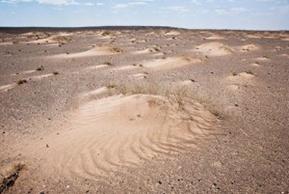 According to a recent study 77.8 percent of the total territory of Mongolia is in danger of desertification to various degrees.
According to a recent study 77.8 percent of the total territory of Mongolia is in danger of desertification to various degrees.Climatic variations are expected to contribute 40 percent of desertification and the environmental impact of human activities are likely to cause the remained. These desertification figures highlight the urgent need to take actions to reduce degradation and desertification and adapt to climate change.
The Ministry of Environment and Green Development of Mongolia has announced the publication of the “Atlas of Desertification” on Wednesday 18th September.
The priority in combating desertification should be the implementation of preventive measures in areas that have not yet begun to degrade or which are in the first stages of degradation. However, it is warned that the severely degraded areas should not be neglected. In combating desertification and drought, the participation of local communities, rural organizations, national Governments, non-governmental organizations and international and regional organizations is essential.
The Deputy Minister of Environment and Green Development B.Tulga said that the Atlas of Desertification summarizes the status of scientific knowledge on the territory where desertification is most prevalent in Mongolia and what contributed to the desertification. The Atlas of Desertification is essential to raise awareness in local communities and provinces on combating desertification.
The Steppe and western region in Mongolia is most affected by desertification according to the study. Mining operations, unpaved multiple tracks, pastoral land overcrowding and other activities related to human activity directly distribute to over 60 percent of desertification and climatic variations and environmental impact lead to 40 percent of desertification.
Long term policy is required to stop desertification. Therefore it is important now to define the current situation. The Atlas of Desertification is designed to create data on desertification in Mongolia based on scientific knowledge.
Desertification is classified as light, moderate, severe and very severe. The degraded areas classified as very severe should be restored by 2-3 percent but moderate areas of degradation should be restored to the light desertification class by a reduction of 15 percent.
Mongolia is ranked as one of the highest countries with desertification in the world. The temperature in Mongolia rose 2.1 °C while the temperature rose on average 0.07 percent in other countries over the past century.
 3,575.44
3,575.44







